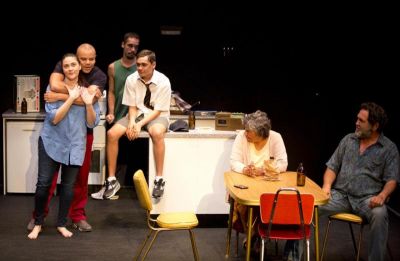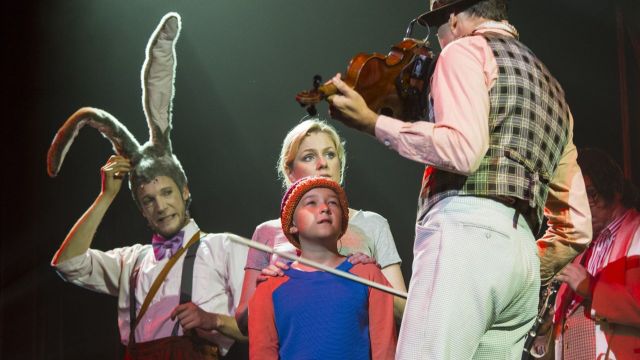Australian Plays Excite Audiences
There’s a new sense of optimism. After going through what one writer describes as a crisis it’s getting easier, albeit slightly, to produce new plays. The healthy crop of new works being performed around the country is proof of the advances being made. Peter Gotting reports.
Suzie Miller’s new play Caress/ Ache hit a nerve for audiences at Sydney’s Griffin Theatre. It may have been the startling timing: the play, which deals with the death penalty, premiered just as two Bali Nine drug smugglers were transferred to an Indonesian prison to be executed.
Griffin’s Artistic Director Lee Lewis says the response was remarkable, with many audience members contacting the theatre to say how the play has affected them. “Audiences are responding to the big emotion of the play,” she says. “People have really enjoyed being able to think about current events and connect to them in ways that they perhaps hadn’t considered.”
The play has sold well for Griffin. But it has also highlighted a problem for Australia’s theatre companies in how they weigh up the success of new works.
Most companies are locked into subscription seasons to provide a level of financial security. But that means they have little flexibility. “You don’t get to find out if a play can run for eight weeks or if it will run two years,” Lewis says. “It doesn’t matter if a play does moderately well or even if it sells out, it’s hard to get a sense of how long it could run.”
 Theatre is not an easy business – and the economics of new plays is particularly difficult. Australia has relatively few theatres, at least when compared to the powerhouses of the UK and the US. But we’re slowly learning not to compare ourselves to those powerhouses, which benefit from significantly larger populations and tourist numbers.
Theatre is not an easy business – and the economics of new plays is particularly difficult. Australia has relatively few theatres, at least when compared to the powerhouses of the UK and the US. But we’re slowly learning not to compare ourselves to those powerhouses, which benefit from significantly larger populations and tourist numbers.
“I think there’s a movement to more courage on behalf of theatre companies and a greater willingness to put on new work,” says theatre director Iain Sinclair, who’s also resident dramaturg at Playwriting Australia. “And there’s a move to putting on work with diversity.”
There are more plays by female writers, indigenous playwrights and theatre makers of diverse backgrounds: names including Nakkiah Lui, Mayu Kanamori, Kylie Coolwell, Future D. Fidel and Ash Flanders. This is providing hope after the dominance of director-led revivals of classics in recent years.
Playwright Reg Cribb says many writers have struggled to attract attention as major companies have focused on names such as Anton Chekov, Tennessee Williams, Arthur Miller, Samuel Beckett and of course William Shakespeare. Local writing has been going through a “slight crisis”, he says. But some of the strongest work is emerging from the fringe. “It’s populated by young, hungry theatre makers, who won’t just write, they’ll direct and produce it because they want to put it on. What that should do is trickle down into the mainstream scene and create energy and bravery.”
Of particular note for Cribb is the strength of indigenous stories. He’s just finished a rehearsal draft of a new work, Country Song, for Queensland Theatre Company, weaving the story of singer Jimmy Little together with other indigenous music stars in a new play. It was conceived with Michael Tuahine, who will star as Little, and will be staged in July.

“We bandied it about to a few people and they all thought it was a good idea,” he says. “But getting it to the stage that we’re actually going to commission it and we’re going to put it on – that’s always the battle.”
While there may be some signs of progress in this battle, Cribb believes more needs to be done. Those stories on the fringe are often staying there. Melbourne’s La Mama has long provided a launching ground for important Australian artists and writers but too often their works are not being picked up elsewhere.
Cribb says mainstream theatre companies need to spend more time and money on development. “A lot of new Australian works are shot in the foot because they’re not ready to go on,” he says. “It’s the same as film and TV.”
But for producers it’s the age-old problem: money. Griffin’s Lee Lewis says she can only commission “one and a half” new plays each year, although she’s finding ways to make that money go further. “With partnerships I can stretch that out to three commissions a year.”
Hence why co-productions between companies across various Australian cities are proving increasingly popular. Julia-Rose Lewis’s Samson, Kate Mulvany’s Masquerade and Angela Betzien’s Mortido are some recent examples, allowing theatres to pool resources and give a new work an important second showing.
There are other ways that theatre companies are making headway too. Melbourne Theatre Company’s Neon season, which links with independent producers, has been “outrageously successful”, Sinclair says. Opportunities are emerging at new venues such as the Eternity Playhouse and Hayes Theatre Company, at least for restaging local works if not premieres. Melbourne’s Red Stitch, which started in 2002, is also being recognised for its work – some of which is new – and Perth’s Aboriginal theatre company Yirra Yaakin has made its mark, not only at home but with tours as well.
The Griffin, which focuses on new Australian writing, has been around since the late 1970s. But Lewis says subscriptions have increased 90 percent over the past three years. “We are now better at reaching people, clearer about the type of work we are doing – and telling our audiences about it.”
Playwriting Australia is optimistic that opportunities will only improve. “The Australian population is growing and our cities are exploding – and with people who aren’t necessarily of Anglo Saxon descent,” Sinclair says. “It’s promising on just that demographic, mathematical level.”
The strength of new plays has long been cyclical but there are hopes we are seeing signs of a renewed focus on local work. “At the moment there’s a trend towards director based theatre,” Cribb says. “But there’s still a lot of new Australian writing going on this year and a lot of work that’s in development. I’m optimistic.”
 According to Sinclair, the wave of director-led adaptations and stagings of classics could benefit all playwrights in the long run. He says the success of classics proves that audiences are “hungry” for plays that are well structured and well written. “What’s happening now is that dramaturgy is being transferred into our new work as well.”
According to Sinclair, the wave of director-led adaptations and stagings of classics could benefit all playwrights in the long run. He says the success of classics proves that audiences are “hungry” for plays that are well structured and well written. “What’s happening now is that dramaturgy is being transferred into our new work as well.”
Playwrights such as Kit Brookman and Declan Greene are becoming more adventurous in their subject matter, he says, as their dramaturgical discipline develops.
It may be too early to tell if 2015 will be a good year but premieres of local plays have been well received by critics and audiences (alongside Caress/ Ache, Masquerade and Kill The Messenger have been highly praised). The test though will be time: which plays are staged again. And while co-productions are giving many playwrights an important second production, it’s still a huge challenge for writers to create plays which will be performed in five, ten or hopefully a hundred years.
But as Lewis points out, it’s hard to match the potential power of a new play. “When you are making a work from nothing, when it actually connects with an audiences, it’s so electric,” she says. “There’s a connection that will happen when you are never going to get with a work from elsewhere. It’s ours and for that we should celebrate.”
Some highlights among new Australian plays this year.
Masquerade by Kate Mulvany, Griffin Theatre Company and State Theatre Company of South Australia, Sydney 9-17 Jan; Adelaide 20-31 May. Read our review.
Caress/ Ache by Suzie Miller. Griffin Theatre Company. 27 feb - 11 Apr. Read our review.
Kill the Messenger by Nakkiah Lui, Belvoir St, Sydney 14 Feb - 8 Mar. Read our review.
Timeshare by Lally Katz, Malthouse Theatre, Melbourne, Apr 23 - May 17. Read our review.
The Waiting Room by Kylie Trounson, Melbourne Theatre Company, 15 May - 27 Jun. Read our review.
Battle of Waterloo by Kylie Coolwell, Sydney Theatre Company, 1-27 Jun. Read our review.
Country Song by Reg Cribb, Queensland Theatre Company, 4 Jul – 8 Aug.
Seventeen by Matthew Whittet, Belvoir St, Sydney, 1 Aug – 13 Sep.
The Fever and the Fret by Jub Clerc, Yirra Yaakin, Perth, 24 Aug – 12 Sep.
Prize Fighter by Future D. Fidel, La Boite, Brisbane, 5 – 26 Sep.
A Sri Lankan Tamil Asylum Seeker's Story as Performed by Australian Actors Under the Guidance of a Sinhalese Director by Dhananjaya Karunarathne, Merrigong Theatre Company, Wollongong, 16 – 26 Sep.
Extinction by Hannie Rayson, Black Swan, Perth 19, Sep - 4 Oct.
Blood Bank by Christopher Harley, Ensemble, Sydney, Oct 16 – Nov 22.
Images (from top): Hasquerade (photographer Jamie Williams), Caress/ Ache (photographer Brett Boardman), Timeshare (photographer Jeff Busby) and Battle of Waterloo (photographer Lisa Tomasetti).
Originally published in the May / June 2015 edition of Stage Whispers - more details.
Subscribe to our E-Newsletter, buy our latest print edition or find a Performing Arts book at Book Nook.

